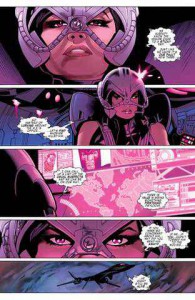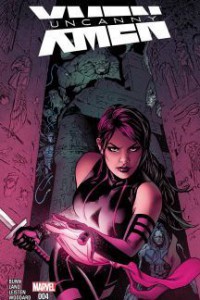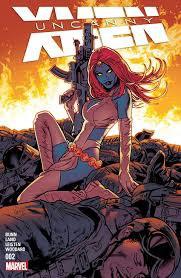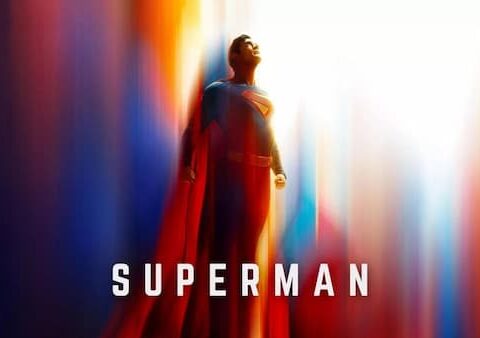At a time where I’ve been finding myself a little ambivalent about current X-Men books, this Uncanny X-Men title has been the saving grace to sustain my ongoing connection to the Mutant world.
As someone whose initiation into comic-books began with X-Men titles in the early 90s and someone who has felt a deep attachment to the X-Men world for most of my life, it is frustrating to find current X-Men titles a little underwhelming.
The All-New X-Men lost its hold on me some time ago, while the Extraordinary X-Men title, centered on Storm and the school, has been largely unimpressive.
But this run of Uncanny X-Men put a lot right.
The ingredients were in place for it to do so.
It helps, for starters, that I’ve wanted to see Magneto at the head of an X-Men team for a long time and this book provides that premise. Add to that the fact that Psylocke has always been one of my favorite comic-book characters and gets to play a major role in this series.
I have, for years, been bothered by how neglected Psylocke tends to be by writers when, really, she should be a major, primary player in the X-Men world. This series gives her the prominence she warrants – and the results are excellent.
In addition to Magneto and Psylocke, the rest of the ‘team’ shapes up pretty well too, with Sabretooth, Monet and an eerily vacant-minded Archangel. It’s a motley group of characters, put together to provide the more edgy, dangerous-feeling Mutant squad of the moment. And the dynamics are strong from the get-go.
Uncanny X-Men #1 doesn’t do anything substantial, but it introduces the group in full-on action/mission mode and establishes the snappy character dynamics.
It also crucially establishes, late on, the role of Psylocke and Magneto as senior figures in the team. I’ve never really perceived any real relationship between Psylocke and Magneto, but what’s written here between them is interesting – and this dynamic is probably the main thing that made me excited about this title and sure that I would be returning every month.

Those two play off each other very well; furthermore, the dialogue here quickly establishes a low-level tension between them and the sense that Betsy is here partly to keep an eye on Erik’s activities.
Uncanny X-Men #2 boasts a totally bad-ass cover of Mystique (always a welcome sight), while opening with Magneto investigating the deaths of multiple mutants. The dynamics here, as expected, are rich: with Erik in remote psychic contact with Psylocke as he goes about his investigation.
A note should be made here too of how immaculate Greg Land’s renderings are. Every character is acutely, perfectly drawn and expressed. Moreover, Jay Leisten’s colors are fluid and lush, bathing the eye in rich visuals from page to page. I mention this in particular here, because I was mesmerised by the images of Psylocke in the opening few pages; not just the sublime way she is drawn and colored, but the way the ambient tone around her is rendered a faint purple to match her iconic colors. The quality of tone and ‘lighting’ in these scenes is impossible to take your eyes off.
Meanwhile, Monet and Sabretooth, it turns out, have pretty good chemistry too and are another two characters who play off each other very well. Somehow, Creed comes off as the nicer of the two, if you can believe that – Monet spends this entire series in super-bitch mode, but it isn’t boring.
Admittedly, I’ve somehow missed years worth of Monet’s development.
My abiding memories of Monet are of the clever, prim young lady who appeared in the pages of The Phalanx Covenant and Generation X (mid-90s – yes, I’m an old boy); so Monet in super-bitch mode is a little bemusing at first. But it makes for good dialogue exchanges.
Essentially, what Cullen Bunn has here is a team centered on two pairs of strong dynamics – Psylocke/Magneto and Sabertooth/Monet.
The clash with the Dark Riders here ends with the murder of the Mutant healer ‘Elixr’, as the early storyline develops further, revealing the Dark Riders’ mission to assassinate all and any mutant healers.
Uncanny X-Men #3, from the very start, vindicated my initial enthusiasm for this book, opening with Psylocke and Magneto in mission mode. They attempt to rescue the mutant Triage from a Dark Riders attack.
But what’s great here isn’t the plot, but the banter and interplay between Betsy and Erik, which makes for thoroughly enjoyable reading. Magneto even gets to be a little funny here, which is enabled really by Besty’s dry wit and the low-level antagonism between the two of them.

The art again is immaculate; Psylocke and all the other main characters look fantastic at every point.
The plot develops slowly and effectively, with multiple elements carefully unfolding. Monet’s encounter in Tibet with Shen Xorn is interesting, while more intrigue is slowly bubbling away between Mystique and Fantomex.
The plot thickens in Uncanny X-Men #4, with Magneto sending off his squad to take on the Dark Riders, while elsewhere the Mystique/Fantomex intrigue builds. Seeing how Shen Xorn in Tibet handles the Dark Riders’ attack is fun: it has a touch of Yoda and the Clone Troopers (ROTS/Order 66) to it. Xorn is such a cool, serene character and he has a great flair for dialogue.
Having Psylocke and the others (minus Magneto) go to Egypt to hunt down the Dark Riders makes for some enjoyable atmosphere, dialogue and banter. Again, this book is visually stunning; every character is immaculately, gorgeously rendered – and not just our guys, but even each of the Dark Riders, who all look fabulous and dynamic.
Uncanny X-Men #5 centers on the confrontation between Magneto’s team and the Dark Riders, but also gives us some more Mystique/Fantomex maneuvering on the side. This issue starts to connect more meaningfully with other X-titles too, with Magneto and co delivering Triage to Storm and the school.
We get some interesting Mutant politics/dynamics here, with Storm offering Psylocke and Monet a place with her team and warning against Magneto’s ‘crusade’. Psylocke’s later talk with Magneto is interesting too; in general, #5 is a good demonstration of Erik always being a step or two ahead of everyone else (including his own team), which is cool to see.
We also have Erik and the others arriving in the Savage Land, which is where they are now to be based.
Uncanny X-Men #6 takes us into the broader ‘Apocalypse Wars’ storyline that is going through the various X-titles. The Psylocke/Warren psychic encounter that opens the book is appropriately eerie and interesting, imbued with an apocalyptic/end-times vibe.
Betsy’s subsequent conversation with Magneto is also engaging, particularly the collage of images depicting Warren’s past as Betsy narrates the story to Erik – it looks great and it also touches all the nostalgia bones.
Betsy and Erik going to ‘Green Ridge’ to investigate Betsy’s vision makes for engaging material. Having these two characters go around like Mulder and Scully is a lot of fun in itself, but this also feels a bit like the early stages of a horror movie – ‘Green Ridge’ is the kind of quiet, deceptively-idyllic suburban setting that lends itself to an old horror flick. Erik’s line “I’m Magneto – I don’t get chills” is also pretty golden.
There’s B-story here too, involving Creed and Monet encountering the Morlock, Callisto, which isn’t quite as interesting. But, in general, this all very effectively written, well paced build-up, stage-setting and intrigue. This works nicely as a slightly esoteric mystery story, from Betsy’s vision of Green Ridge’s destruction and ‘Dark Angel’ rising to Erik and her coming upon the inexplicable sight of a golden-haired Warren preaching scripture to a congregation.

The Apocalypse Wars material continues with Uncanny X-Men #7, as Elizabeth and Erik follow the mysterious ‘Warren’ figure right into a gathering of Apocalypse’s followers, led by Genocide.
In the B-story, Creed and Monet are shown around the new underground Morlock hiding places, where both Mutants and humans have begun living like Morlocks in order to be safe from the Terrigen mists. Here, Monet finds out that Callisto brought her here because it is her brother – Emplate – who is feeding on Morlocks.
There’s a lot going on here in both stories, but no resolution as of yet. It’s all good, interesting stuff though – and seeing Magneto and Psylocke let loose and kick ass as a duo is a brief pleasure.
Uncanny X-Men #8 avoids Magneto and centers instead on Psylocke escaping captivity by the Clan Akkaba and, elsewhere, on Monet’s reunion with her brother, Emplate. I’m glad to see Emplate back: not only because it harkens back to my adolescent reading days (Generation X in particular), but because Emplate is one of the most genuinely disgusting, unsettling villains around. And what is particularly frightening about him is that he isn’t some mad tyrant with an ego or someone hungry for power, nor he is a practised villain: but simply a creature who needs to feed on his victims in order to maintain his existence.
Psylocke’s bitter clash with Fantomex sparkles a little too, as they trade barbs and much bad blood.
Uncanny X-Men #9 goes deeper into the Monet/Emplate struggle, while Psylocke unwittingly unleashes something akin to an apocalypse (not Apocalypse – but an apocalypse situation).
It’s also always nice to have a Mystique/Magneto reunion, which we get here.
Uncanny X-Men #10 brings this arc to a conclusion, but doesn’t do so entirely satisfactorily. After all of this, having ‘Warren’ simply re-merge with Archangel by some magical, unexplained means seems like a cop out in storytelling terms: literally, just a reset to finish the story.
For a story arc that has featured some very strong material and build-up, it’s a rather lame ending. That being said, there’s still some enjoyable material here, more so with Monet and Creed this time. Monet’s clash with her brother, Emplate, comes with a price – namely that she now has the essence of Emplate within her and will need to feed as if she were him.
Creed’s sympathetic attitude towards Monet at the end, and his offer to keep her situation secret and to take care of her, demonstrates how strong this Creed/Monet relationship has become in this book – and it’s a good thing. Actually, seeing Creed show this kind, tender side of himself was reminding me a lot of Age of Apocalypse and Victor’s relationship with Blink.
Uncanny X-Men #11 and #12 are largely forgettable, but they keep things ticking along. #13 goes in a more interesting direction, as the investigation of the Someday Corporation and their activities leads Mystique to discover an old friend of ours – specifically, Exodus.
I get a kick out of seeing Exodus show up, as he was one of the most prominent, interesting Mutant figures back in my early X-Men reading days and figured prominently in some of my all-time favorite storylines.
A lot of this is good, old-fashioned intrigue bubbling along a steady pace, with a lot of Mutant politics and personality clashes along the way, stemming from Magneto’s dealings with the Hellfire Club and Psylocke’s growing mistrust and resentment of Magneto.
Uncanny X-Men #14 offers some pay-off and is a peak in quality after several months of slight dip. The tension between Psylocke and Magneto reaches its apex and its consequence – specifically, with Betsy parting ways with Erik and his team.
As much as I enjoyed seeing the two of them together as the senior figures in this mix, there’s something I like a lot about having Elizabeth take a stand against him when she feels he has crossed a line. It demonstrates that the writer has a good handle on her character and that she still has a measurable ethical or moral standard that she isn’t willing to go beyond.

The way this parting exchange between her and Magneto is presented is also superb; with an initial scene of Psylocke saying her goodbye to the team and having a few, brief words with Erik, and then a later scene in flashback where we also get the telepathic exchange that the two of them had in the same moment, but which no one else was privy to.
It is clever writing and it also reinforces my love for Psylocke as a character.
We also get the confrontation here between Magneto and his former worshipper/agent, Exodus. This too is pretty strong stuff, showing how far apart the two of them are in outlook, intention and interpretation.
These last few issues have seen some dipping in the overall quality level; but when you’ve got Psylocke, Mystique, Magneto and even Exodus all featuring prominently in a comic book, it is difficult to be too critical.
Uncanny X-Men #15 made me a happy boy; being, as it is, solely a Psylocke story (okay, a Psylocke/Mystique story – which is arguably even better).
It’s nice here, seeing Betsy off on her own, going from place to place and kicking arse, working off the ‘hit list’ (I say again: a Psylocke solo title is long overdue). Her showdown with Mystique (who isn’t on her hit-list, but is the one who seeks her out) is fun, getting us an appropriate glimpse into both of their minds.

The question of whether Mystique was sent by Magneto to kill her or just to spy on her is left unresolved; but this is, at any rate, a nice little Psylocke story that is beautifully drawn and colored.
#16 and #17 take us into Inhumans Vs X-Men territory. I was genuinely chuffed to have Magneto seek out Rachel Grey and for her to be brought into this title, both because I’m a big fan of the character and because this book could use the injection of new energy and perspective.
Uncanny X-Men #17 is a particularly strong installment, even though it is more like a self-contained little episode that barely links to the broader IvX business.
Here, Rachel and Sabretooth are in Limbo, along with Monet, and along with some of the Inhumans who Storm and co deliberately banished here (see IvX). What’s nice here is seeing Rachel’s discomfort and regret at the Inhumans being put here, particularly given the lack of remorse from other characters in the events of the main IvX story.
But the bulk of this book is taken up by Sabertooth and Monet. Creed’s inner thought processes here are really interesting, revealing his difficulties in keeping the monster – his ‘real self’ – at bay and maintaining his Good Guy persona. This book does a very good job of exploring that struggle so that we, as readers, are under no illusions about Victor’s former nature having been conquered and neutralised.
But what is also impressive about this issue is that goes to a dark place and ends on a dark note: with Victor literally giving Monet/Emplate an Inhuman victim to feed on. In his mind, this is Victor being loyal to Monet and going to dark lengths to help her survive her own problem; but it’s a horrible moment that really makes you wonder whether Psylocke was the only genuinely ‘Good Guy’ in this team (and now she’s gone).
But the fact that this happens and it isn’t moralised or justified in any way is a credit to the writing.
Uncanny X-Men #18, again tieing into the IvX event, tells another surprisingly self-contained micro story, this time involving Shen Xorn and his struggle to maintain a peaceful sanctuary with Inhumans when the Inhuman vs Mutant situation is so intensely mistrustful.
It’s one of the less eventful issues in the series, but it does have some poetry to it and is engaging. It manages to make you sympathise with or identify with a bunch of minor Inhumans that we’re probably never going to see again; it is also a nice spotlight on Shen Xorn and a rare story for him, which is a plus.
We come to an end with Uncanny X-Men #19, and it is, fittingly, a standout issue that brings closure to an underlying theme that has permeated this series – the uneasy relationship between Psylocke and Magneto.
This final issue of the series (before the X-Men books all reboot and begin anew) focuses solely on these two characters, with everyone else left aside. Specifically, Psylocke has tracked down Magneto and has come to end his life.
There are perhaps problems here. One is that I’m not entirely convinced she would come to kill him. Another is the ending: I try to avoid blatant spoilers where possible, but it suffices to say that death – more often than not – is a fast and loose thing in the Marvel Universe.
That being said, Uncanny X-Men #19 has a lot to recommend it.

A to-the-death showdown between Psylocke and Magneto, aided by some fabulous art and visuals, for one thing. Even here, at the end of the run, I continue to love and appreciate the fact that Betsy Braddock has been given major prominence and respect in this series, and that this final issue is so much about her.
While I don’t entirely buy that her relationship with Magneto (which, at least for the first several months, was my favorite thing about this title) would quite come to this extreme a conclusion, I do appreciate the qualities with which the idea is presented in dramatic and artistic terms.
Being alternately inside Psylocke’s and Magneto’s thoughts as this reckoning unfolds is particularly engaging, as both of their thought-processes here are interesting. The finish is dramatic; though, as mentioned, all isn’t as it seems.
As an end-point for this series, it isn’t perfect – but it’s at least a substantial episode to close off this particular saga.
For any fan of Psylocke, this is a must-read comic book. It’s also good to see Elixr put to use, and an appearance here by Exodus is both logical and welcome.
As the X-Men books relaunch in a different direction now, I hope for good things: but I also hope that Psylocke continues to feature prominently somewhere in the mix. I have a bad feeling she is going to be lost in the shake-up – but I hope not.
This series gave her an all-too-rare window to shine and this has been one of the best things – probably the best thing – about this Uncanny X-Men run.
As for this series as a whole, it has faltered in places; and it probably lost some steam and momentum somewhere after the first several months. But, of the three main X-Men titles at this time, it has been by far the strongest one in terms of character building, writing and even art.
The character dynamics have also been strong throughout. And I’m going to miss the Magneto/Psylocke dynamic, the fact of Magneto leading an X-Men team, and the prominence afforded to Psylocke in general.
One thing this book – and this line-up – shows is the rich diversity of the X-Men tapestry: and how you can bring all kinds of characters together as the principal players in a title without having to give permanent prominence to the same old standards over and over again.




